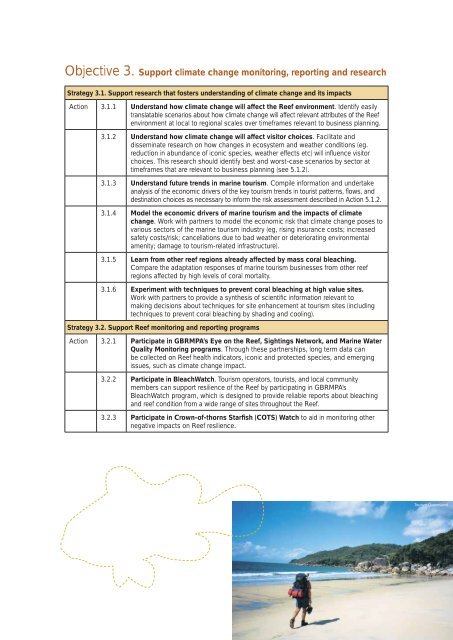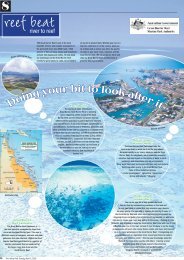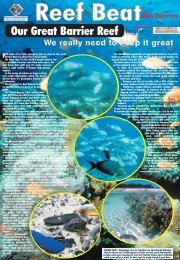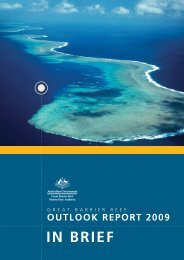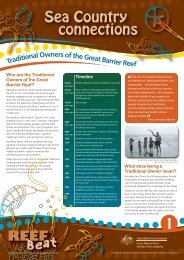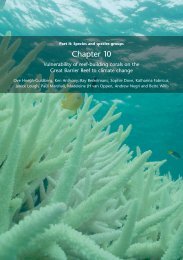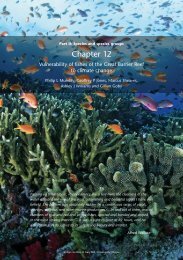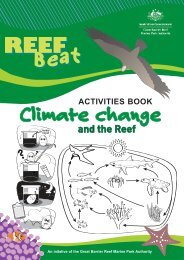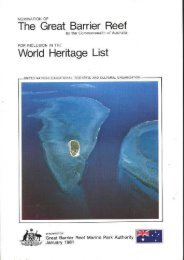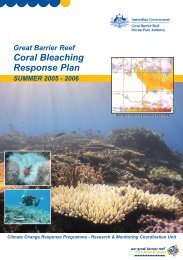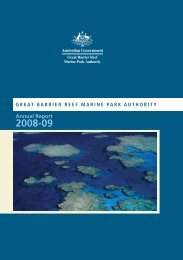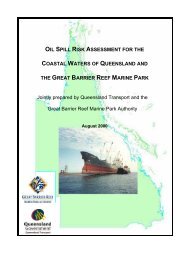Great Barrier Reef Tourism Climate Change Action Strategy 2009 ...
Great Barrier Reef Tourism Climate Change Action Strategy 2009 ...
Great Barrier Reef Tourism Climate Change Action Strategy 2009 ...
Create successful ePaper yourself
Turn your PDF publications into a flip-book with our unique Google optimized e-Paper software.
Objective 3. Support climate change monitoring, reporting and research<br />
<strong>Strategy</strong> 3.1. Support research that fosters understanding of climate change and its impacts<br />
<strong>Action</strong> 3.1.1 Understand how climate change will affect the <strong>Reef</strong> environment. Identify easily<br />
translatable scenarios about how climate change will affect relevant attributes of the <strong>Reef</strong><br />
environment at local to regional scales over timeframes relevant to business planning.<br />
3.1.2 Understand how climate change will affect visitor choices. Facilitate and<br />
disseminate research on how changes in ecosystem and weather conditions (eg.<br />
reduction in abundance of iconic species, weather effects etc) will infl uence visitor<br />
choices. This research should identify best and worst-case scenarios by sector at<br />
timeframes that are relevant to business planning (see 5.1.2).<br />
3.1.3 Understand future trends in marine tourism. Compile information and undertake<br />
analysis of the economic drivers of the key tourism trends in tourist patterns, fl ows, and<br />
destination choices as necessary to inform the risk assessment described in <strong>Action</strong> 5.1.2.<br />
3.1.4 Model the economic drivers of marine tourism and the impacts of climate<br />
change. Work with partners to model the economic risk that climate change poses to<br />
various sectors of the marine tourism industry (eg, rising insurance costs; increased<br />
safety costs/risk; cancellations due to bad weather or deteriorating environmental<br />
amenity; damage to tourism-related infrastructure).<br />
3.1.5 Learn from other reef regions already affected by mass coral bleaching.<br />
Compare the adaptation responses of marine tourism businesses from other reef<br />
regions affected by high levels of coral mortality.<br />
3.1.6 Experiment with techniques to prevent coral bleaching at high value sites.<br />
Work with partners to provide a synthesis of scientifi c information relevant to<br />
making decisions about techniques for site enhancement at tourism sites (including<br />
techniques to prevent coral bleaching by shading and cooling).<br />
<strong>Strategy</strong> 3.2. Support <strong>Reef</strong> monitoring and reporting programs<br />
<strong>Action</strong> 3.2.1 Participate in GBRMPA’s Eye on the <strong>Reef</strong>, Sightings Network, and Marine Water<br />
Quality Monitoring programs. Through these partnerships, long term data can<br />
be collected on <strong>Reef</strong> health indicators, iconic and protected species, and emerging<br />
issues, such as climate change impact.<br />
3.2.2 Participate in BleachWatch. <strong>Tourism</strong> operators, tourists, and local community<br />
members can support resilience of the <strong>Reef</strong> by participating in GBRMPA’s<br />
BleachWatch program, which is designed to provide reliable reports about bleaching<br />
and reef condition from a wide range of sites throughout the <strong>Reef</strong>.<br />
3.2.3 Participate in Crown-of-thorns Starfish (COTS) Watch to aid in monitoring other<br />
negative impacts on <strong>Reef</strong> resilience.<br />
<strong>Tourism</strong> Queensland


